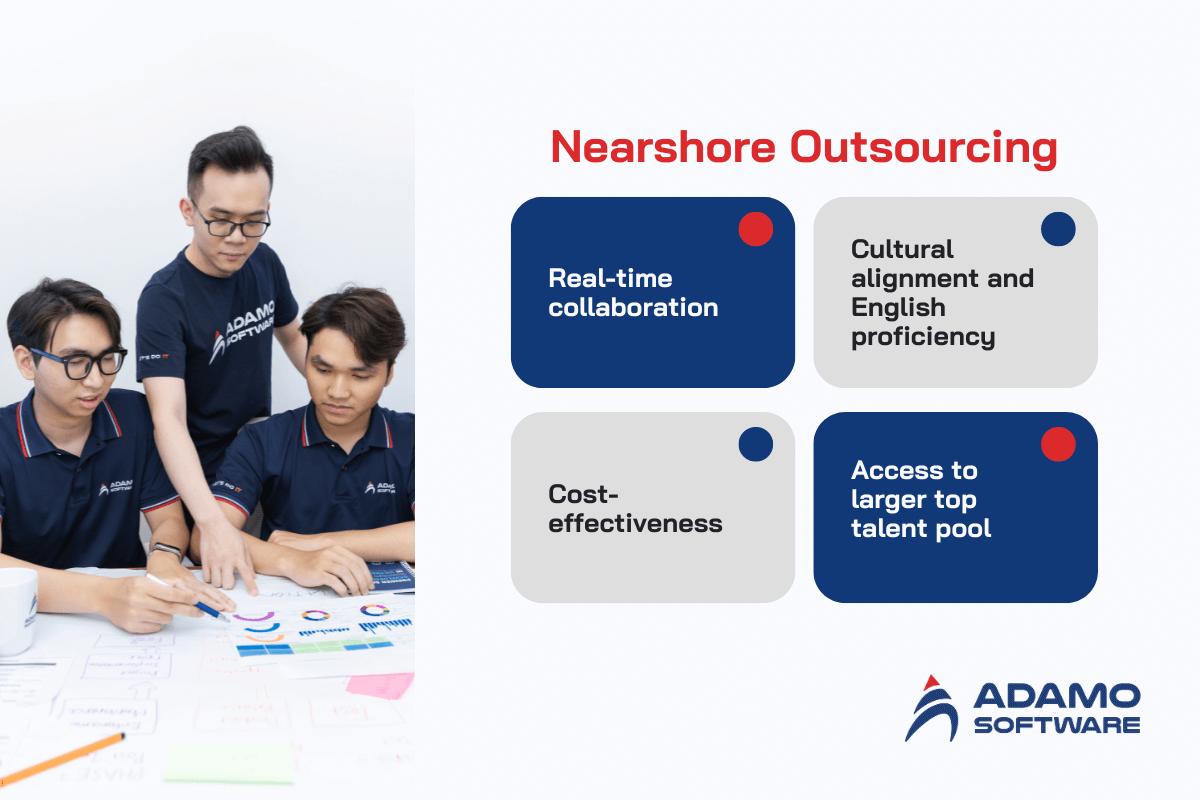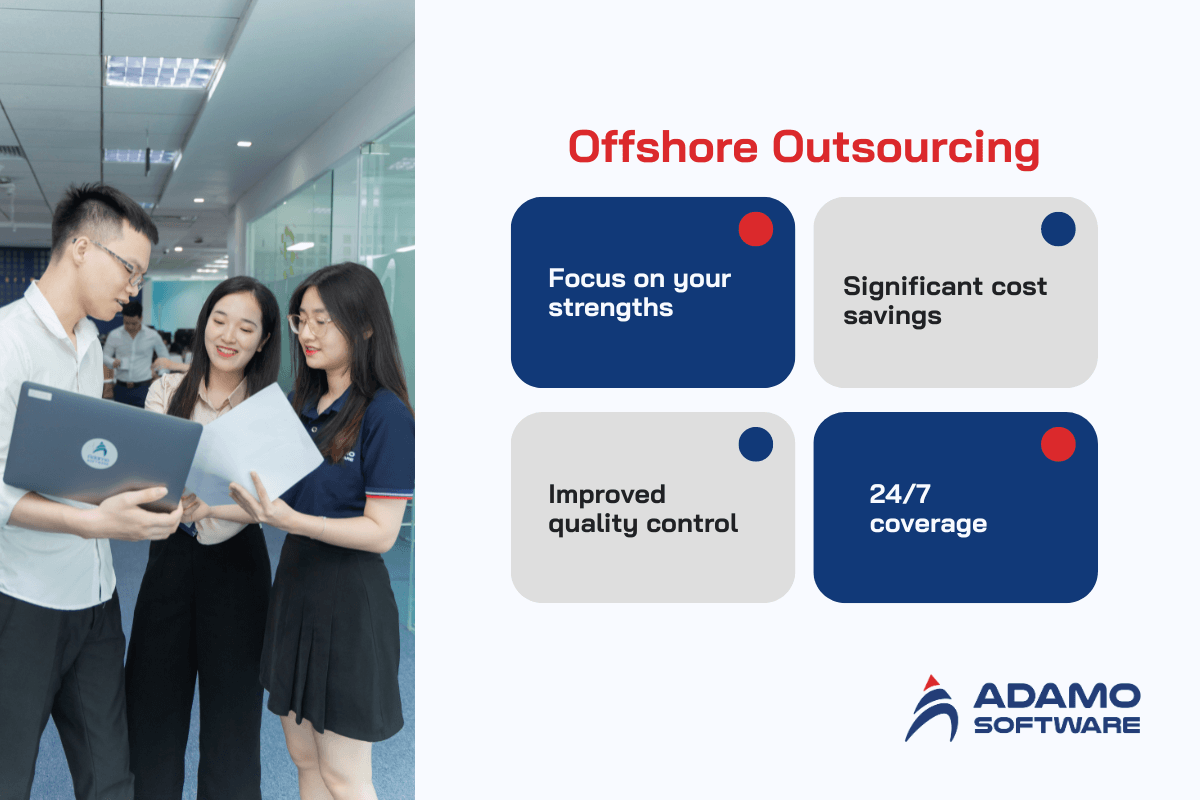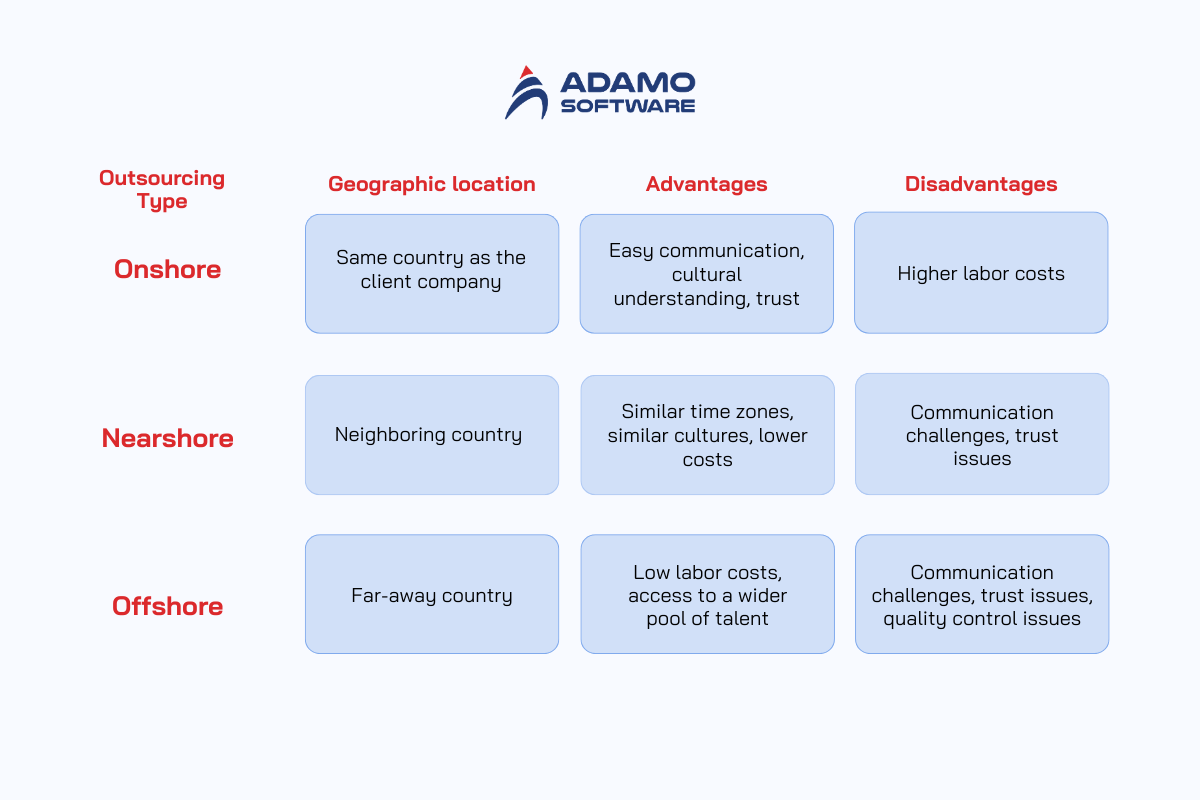Onshore, Nearshore, Offshore Outsourcing – How to Choose 2026

This blog highlights the advantages and disadvantages of Onshore, Nearshore, Offshore Outsourcing models, helping you make an informed decision that aligns with your company’s specific needs and requirements.
With the rising demand for technical talent globally and shifts in how and where skilled professionals work, businesses now have various IT outsourcing models to explore. Each project on a development team’s schedule may require a different staffing solution, and technical staffing firms can assist in finding the right outsourcing engagement model for your company’s needs.
Whether you’re filling technical gaps in your existing team or searching for specialized skills, an experienced IT staffing agency can guide you through the differences between onshore, nearshore, and offshore outsourcing models.
We’ll highlight the advantages and disadvantages of each, helping you make an informed decision that aligns with your company’s operational requirements.
I. Onshore Outsourcing
1. What is Onshore Outsourcing?
Onshore outsourcing involves hiring services from a company outside your own but within the same country. The goal is to have a third party handle important but non-core tasks, like human resources functions. Compared to offshore and nearshore outsourcing, onshore outsourcing allows for better control and closer interaction between companies. However, it can be more expensive than other outsourcing models.
2. Benefits of Onshore Outsourcing

_ Easier communication: Communicating is simpler when everyone speaks the same language. Working within the same time zone also makes coordinating with suppliers much more manageable.
_ No cultural differences: Onshore outsourcing avoids the cultural issues that can come with offshore outsourcing. For example, onshore suppliers observe the same holidays as their customers, so there are no unexpected downtime periods. Different cultures also have varying approaches to feedback and business practices, which can lead to misunderstandings and delays in offshore projects.
_ Cost savings: While offshore outsourcing is often seen as cheaper, onshore outsourcing can save money in other ways. It is less costly and time-consuming to meet with an onshore provider in person. Also, onshore projects require less management effort, as there are fewer cultural and time zone barriers. Onshore providers are usually more familiar with the company’s procedures, reducing the need for extensive training and oversight.
_ Better quality control: Addressing quality control issues is easier with onshore outsourcing. If a company needs to train a supplier, it’s simpler to meet in person and ensure they understand the requirements.
_ Intellectual property (IP) protection: The U.S. has strong laws to protect intellectual property. Outsourcing within the country in this case can reduce the risk of exposing sensitive data to countries with weaker IP enforcement.
3. Drawbacks of Onshore Outsourcing
_ Limited oversight: Even though onshore staff may have more in common with a company’s internal team, managers won’t have direct, in-person oversight over remote workers, even within the same country.
_ Integration challenges: It can take time to integrate a company’s on-site employees with the onshore service provider’s staff. Good communication tools help, but distance and time can still affect how well people work together.
4. Example of Onshore Outsourcing
A local business might outsource its software development to a local company that offers reliable and skilled developers. This can be more efficient than managing the development in-house.
Companies with strict legal and operational requirements, such as those needing to keep customer data within their own country, often use onshore outsourcing. For instance, a financial software development project might need to comply with local data protection laws.
Additionally, a company in a costly city like New York or San Francisco might find it expensive to hire a new team for a DevOps project. Instead, they could outsource to a qualified development team in a smaller, less expensive city, like one in Georgia. This can reduce costs while still ensuring the project is completed on time and meets expectations.
5. When You Should Choose Onshore Outsourcing
Onshore outsourcing can be simpler than other types of outsourcing because you don’t have to deal with different countries’ laws and you can use your usual currency.
However, it’s important to outsource when it makes sense for your team’s workload and skills. Here are three signs that outsourcing might be the right choice for your business:
_ New tasks are distracting from core business: As your company grows, tasks that used to be minor can take up more time, interfering with your main business activities. For example, many companies outsource software quality assurance because it can be more efficient and cost-effective than hiring full-time staff.
_ Lack of space for new employees: Finding and paying for more office space can be expensive and impractical. Onshore outsourcing allows you to expand your team without needing to move to a bigger office or overcrowding your current space.
_ Need for additional tools and expertise: If you need to do tasks outside your main business areas, you might require external experts. While hiring consultants is an option, outsourcing lets you have ongoing access to expert help.
II. Nearshore Software Development
1. What is Nearshore Software Development
Nearshore is an outsourcing model where your custom software development needs are fulfilled by distributed teams located in a nearby country within the same continent or within the same or similar time zone.
For business leaders in the United States, this means outsourcing your product development needs to a Nearshore software development company in Latin America; whereas Western European countries outsource to nearby countries in Eastern Europe, like Poland or Ukraine.
Clutch reports that 90% of small businesses plan to outsource business functions, including IT and software projects, in 2022. 21% of those small businesses outsourcing tasks in 2022 intend to hire a Nearshore outsourcing company, up from 15% in 2021.
2. Advantages of Nearshore Software Development

_ Real-time collaboration: One of the biggest benefits of working with nearshore software development teams is that they are in the same time zone as your business. This means you can collaborate in real-time, avoiding the typical delays you might face with offshore teams. In today’s fast-paced Agile development environment, having no lag is crucial to staying competitive. Also, it’s easier and quicker to arrange face-to-face meetings with nearshore teams.
_ Cultural alignment and English proficiency: Nearshore teams in Latin America share cultural similarities with the U.S., and many people speak English fluently. This reduces language and cultural barriers, leading to a more cohesive team and smoother collaboration compared to offshore teams.
_ Cost-effectiveness: Nearshore outsourcing is more affordable than onshore options while offering better alignment and fewer barriers than offshore outsourcing. Though it might be slightly more expensive than offshore, nearshore outsourcing often provides better value for your investment. If you want the benefits of onshore outsourcing without the high costs or the challenges of offshore outsourcing, nearshore is a great choice.
_ Access to larger top talent pool: Take the U.S. as an example. There’s a growing demand for software developers worldwide, and the U.S. faces a shortage of qualified professionals. However, location is less important than talent. Latin America has a large pool of highly skilled nearshore developers ready to work on your projects, providing a valuable resource for companies needing top-notch talent.
3. Disadvantages of Nearshore Software Development
_ Legal complications: Your nearshore development partners will be operating under different legal systems. While things may run smoothly most of the time, any issues that arise can become complicated to resolve due to the differing jurisdictions. Legal disputes can be challenging to manage across multiple territories simultaneously.
_ Difficult to manage project timelines: If communication breaks down, project management can suffer, and deadlines may be missed. Without regular updates and progress meetings, nearshore teams might lose sight of the main business objectives, leading to delays and misalignment.
_ Poor ongoing monitoring: Ongoing monitoring can also present challenges. If your nearshore partner is not conveniently located, traveling for in-person meetings can become time-consuming and costly. As a result, this can hinder effective collaboration and oversight, impacting the overall project’s success.
4. Example of Nearshore Outsourcing
Picture this: a company based in the U.S. might choose to outsource to countries like Canada or Mexico, which are considered nearshore locations, so that they can benefit from the advantages mentioned earlier, such as cost savings and easier communication due to the similar time zone.
5. When You Should Choose Nearshore Software Development
When your project requires frequent and real-time communication, nearshore outsourcing is ideal as Nearshore teams operate in similar or the same time zones, making it easier to have live discussions, quick feedback, and immediate problem resolution.
Besides, when cultural and language alignment is essential in your project, nearshore outsourcing can be beneficial. And, if your project requires face-to-face meetings, nearshore outsourcing makes travel easier and less expensive.
III. Offshore IT Outsourcing
1. What is Offshore IT Outsourcing
Offshore outsourcing means hiring workers from other countries to handle certain tasks. Companies often outsource IT operations to countries like Vietnam or India because labor is cheaper there.
In recent years, this practice has become popular in many industries. It started with manufacturing companies moving production from the U.S. to developing countries like Vietnam. Now, even service providers are looking for affordable talent overseas.
Offshore IT outsourcing offers benefits like lower labor and operating costs, but it also comes with risks such as dealing with different time zones and relying on your partner to maintain high-quality work.
2. Benefits of Offshore IT Outsourcing

_ Focus on your strengths: You may be great at what you do, but handling everything else can be challenging. For example, if you’re a marketer, you might not know much about coding. By outsourcing your development efforts, you can focus on marketing while experts handle developing your products.
_ Significant cost savings: Hiring full-time employees means paying for salaries, benefits, office space, and equipment. Outsourcing eliminates these costs. You save money and gain access to talented professionals, improving your business without the added expenses.
_ Improved quality control: Overworked IT departments can lead to poor-quality work. Outsourcing lets you bring in additional resources when needed, ensuring tasks are handled properly and efficiently.
_ 24/7 coverage: With outsourcing, your customer service can be available around the clock without paying extra for night shifts. Outsourced partners work their regular hours, covering your business needs while you sleep at a cost-effective rate.
3. Disadvantages of Offshore Outsourcing
_ Trust and control issues: Trusting an overseas provider with your operations can be difficult. You might worry about relying too much on them, as they have the workforce and technology to run your business.
_ Communication and language barriers: Working with a company that speaks a different language can lead to communication issues and misunderstandings.
_ Misaligned business goals: Two companies working together might have different objectives, causing conflicts and problems in achieving common goals.
_ Cultural differences: While offshore outsourcing allows you to use foreign expertise, cultural differences can affect communication styles and business practices, leading to potential misunderstandings.
4. Example of Offshore Outsourcing
Offshore outsourcing is a strategy that many U.S.-based tech companies employ to maximize their resources and achieve their business objectives. For instance, let’s consider a scenario where a U.S. tech company specializes in developing mobile apps.
With the desire to create a new app, the company recognizes the potential expenses of hiring local developers. To alleviate this financial burden, they opt to outsource the app development to a team located in Vietnam.
5. When to Choose Offshore Outsourcing
Today, businesses recognize that offshore outsourcing offers more than just cost savings. It’s becoming a strategic approach to overcoming global market challenges and driving business growth.
One of the primary reasons companies choose offshore outsourcing is the potential to reduce labor costs by up to 70-90%. In times of economic uncertainty, maintaining steady revenue while controlling expenses is difficult. Offshoring outsourcing provides a viable solution to keep operations running smoothly and support growth, especially when local costs are prohibitively high.
What’s more, in a highly competitive market, achieving optimal results is crucial. If you want to enhance your efficiency and streamline processes, opting for offshore is an ideal choice. Thanks to this, you can stay ahead and become more adaptable to market changes.
When you want to access global talent and resources, consider leveraging offshore expertise so that you can continue to evolve and strengthen your market position.
IV. Onshore, Nearshore, Offshore – What is the Best
Whether you’re considering offshore, nearshore, or onshore software development outsourcing, there isn’t a one-size-fits-all solution for every business or project. Each approach has its own strengths and works best under specific conditions and expectations. Your choice depends on the resources available to you and the nature of the work involved.

Projects that are best suited for onshore outsourcing:
_ Those requiring frequent in-person collaboration.
_ Projects with strict data privacy requirements regarding developers’ locations.
_ Tasks involving physical components like IoT sensors or smart machines that need on-site development.
Projects that are best suited for nearshore software development:
_ Developing B2B, B2C, and SaaS solutions.
_ Projects requiring real-time collaboration but not necessarily face-to-face interactions.
_ Strategic projects with complex and evolving requirements that need continuous collaboration.
_ Developing new software solutions or modernizing existing complex legacy software systems.
Projects that are best suited for offshore development:
_ Non-automated processes that involve repetitive tasks.
_ IT support projects.
_ Projects with clear and less strategic objectives.
_ Tasks that don’t require intensive collaboration or an Agile approach.
_ Projects less affected by high turnover rates.
Also read: IT Outsourcing models – Which one do you need
V. Adamo Software – An Ideal Partner for Your Software Development Project
At Adamo Software, we ensure that your project is handled by experts with the right technical skills and experience. Our dedicated team helps bring diverse perspectives and innovative solutions to the table.
Besides, we recognize the importance of balancing quality and cost. Adamo delivers top-notch software solutions that meet your budgetary constraints. We provide high-quality development services at competitive rates, ensuring you get the best value for your investment.
We are also dedicated to understanding your business needs and working closely with you throughout the development process. We prioritize clear communication, transparency, and accountability, ensuring that our collaboration results in successful outcomes and long-term satisfaction.
If you’re looking for a partner for your next software development project, partner with Adamo Software now and experience the benefits of working with a company committed to excellence, innovation, and client success.











